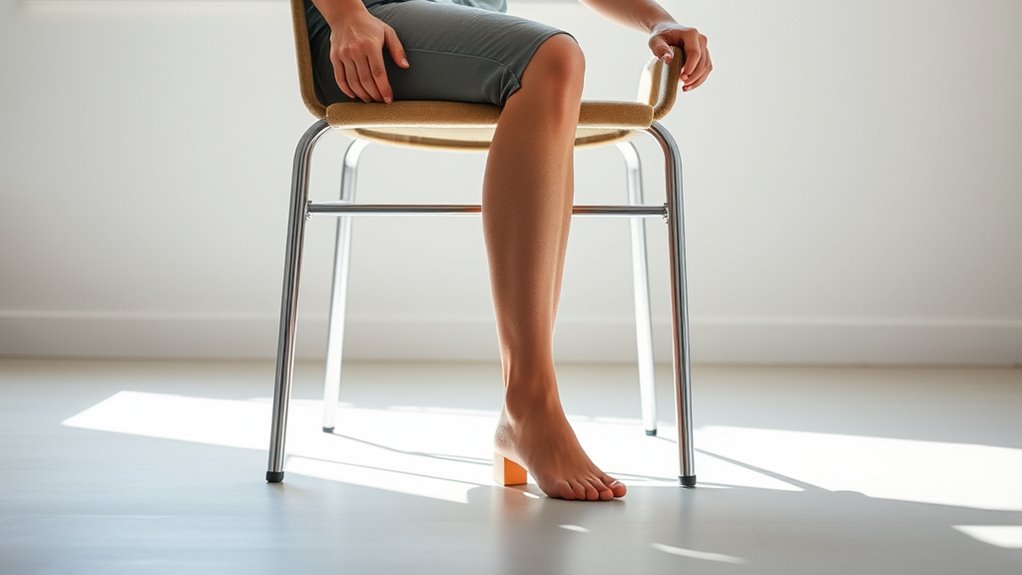To switch smoothly between sitting and standing, start by adjusting your workstation gradually using a height-adjustable desk. Pay attention to your posture, keeping your hips and knees at about 90 degrees, and make certain your monitor is eye level. Take short breaks to stretch your hamstrings, calves, and back to prevent stiffness. Listen to your body and switch positions when you feel discomfort. Keep exploring these tips to make transitions even easier.
Key Takeaways
- Transition gradually by raising or lowering your desk in small increments to prevent dizziness or strain.
- Maintain proper posture during changes, keeping shoulders relaxed and spine aligned.
- Use timers or reminders to switch positions every 30-60 minutes for consistency.
- Engage in light stretching during transitions to activate muscles and improve circulation.
- Shift weight evenly on both feet when standing to enhance stability and reduce fatigue.

Switching between sitting and standing throughout the day can boost your energy levels and improve your posture. To make this progression smooth, start by setting up an ergonomic desk setup that supports your activity, whether sitting or standing. An ergonomic desk setup means your monitor is at eye level, your keyboard and mouse are positioned comfortably, and your feet rest flat on the floor. Proper alignment reduces strain on your neck, shoulders, and back, making it easier to alternate between positions without discomfort. When you shift from sitting to standing, do so gradually to prevent sudden muscle strain. Use height-adjustable desks or workstations to find a comfortable standing position, keeping your hips and knees at roughly 90-degree angles.
Create an ergonomic workspace with monitor at eye level and feet flat for comfortable sitting and standing transitions.
Incorporate muscle stretching routines into your daily schedule to ease tension and improve circulation. Stretching helps loosen muscles that tend to tighten when you sit for extended periods, reducing the risk of discomfort or injury. Focus on stretches that target your hamstrings, calves, hip flexors, and lower back, as these areas often become tight from prolonged sitting. When progressing to standing, take a moment to stretch your legs and back, which helps activate muscles that may have become sluggish. Stretching routines don’t need to be lengthy; even a few minutes every hour can make a significant difference. Additionally, paying attention to proper posture during transitions can help prevent strain and fatigue.
As you alternate between sitting and standing, listen to your body. If you start to feel fatigue or discomfort, it’s a sign to change positions. Use timers or apps to remind yourself to switch positions regularly, ideally every 30 to 60 minutes. During these breaks, perform light muscle stretching routines to keep blood flowing and prevent stiffness. Remember to shift your weight evenly on both feet while standing, and avoid locking your knees. When sitting again, adjust your chair height so your feet are flat on the ground and your hips are slightly higher than your knees. This balance helps maintain good posture and keeps your muscles engaged without overstraining.
Finally, pay attention to your overall posture throughout the day, whether sitting or standing. Keep your shoulders relaxed, your back straight, and your head aligned with your spine. Small adjustments, combined with ergonomic considerations and muscle stretching routines, make switching between sitting and standing seamless and beneficial. Over time, these habits will boost your comfort, energy, and overall health, making your workday more productive and less taxing on your body.
Frequently Asked Questions
How Often Should I Switch Between Sitting and Standing Daily?
You should aim to switch between sitting and standing every 30 to 60 minutes. Using ergonomic furniture helps support proper posture during these changes. Remember to stay posture aware, ensuring your hips are level and your shoulders relaxed whether sitting or standing. Regular movement prevents strain and boosts circulation. By maintaining this routine, you’ll reduce discomfort and improve overall comfort throughout your workday.
Are There Any Health Risks Associated With Frequent Position Changes?
Think of your body as a well-tuned instrument, always in harmony. Frequently changing positions can help avoid ergonomic hazards and boost circulation, but overdoing it may cause strain or discomfort. You might experience circulation concerns or muscle fatigue if you switch too often or too quickly. To stay balanced, listen to your body, switch seamlessly, and maintain proper posture, ensuring your shifts support your health rather than compromise it.
What Are the Best Exercises to Ease Transition Discomfort?
To ease shift discomfort, try ergonomic stretches like gentle hamstring and calf stretches before standing. Incorporate muscle relaxation techniques such as deep breathing or progressive muscle relaxation to loosen up your muscles. These exercises help reduce stiffness and improve circulation, making it easier to switch positions smoothly. Remember to move slowly and listen to your body, preventing strain or dizziness during the transition.
Can Switching Positions Improve Posture and Reduce Back Pain?
Switching positions can definitely improve your posture and reduce back pain. Using ergonomic chairs helps support your spine properly, encouraging better posture. Alternating between sitting and standing engages different muscles, preventing stiffness and strain. To maximize benefits, maintain good posture during both activities and incorporate posture correction exercises. This dynamic approach keeps your back healthy, minimizes discomfort, and promotes overall comfort throughout your day.
What Equipment Can Help Facilitate Easier Sitting-Standing Transitions?
You can make sitting-standing shifts easier by using equipment like ergonomic chairs and sit-stand desks. Ergonomic chairs support your posture when sitting, reducing strain. Sit-stand desks allow you to effortlessly change positions throughout the day, minimizing discomfort. Adding accessories like anti-fatigue mats or adjustable footrests can also help. These tools promote smooth, comfortable shifts, helping you stay active and reduce the risk of back pain during your workday.
Conclusion
Remember, switching between sitting and standing can boost your energy and reduce discomfort. Did you know that standing for just 15 minutes every hour can improve circulation and alertness? By making these shifts smooth, you’ll stay comfortable and focused throughout the day. So, take small steps, listen to your body, and enjoy the benefits of a more dynamic routine. Your body will thank you for it, one balanced move at a time.









